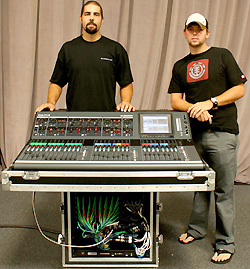
In monitor world, Scott Ferguson is running stereo in-ears for all the bands, with an added subwoofer wedge for the drummer. Out at FOH, Bill Chase’s output configuration includes stereo mains, plus a pair of frontfill outputs, deployed via the console’s matrix, and a dedicated subwoofer pair. “I really like the console’s dedicated sub preset, because it’s differentiated from a regular Aux Send, and it’s always on the surface. Very cool design.”
After helping set up Paisley’s main PA in the morning, the two engineers move to the Water World Stage in the afternoon. Scott Ferguson handles the mic placements, with Bill Chase doing final tweaks before moving to FOH. Typically, the first act takes the stage at 4:45 and things continue until 6:25, just before the doors to the main venue are opened. “There’s no time for sound checks, so we use the same presets every day,” notes Ferguson. “We might have to do a little tweaking, maybe due to traffic noise, or if we have to set up near a brick wall, but the EQ and effects on this desk make that pretty easy.”
The post-show procedure is equally streamlined. “We’re expected to get out by 8:00, including PA, lights and stage,” he says. “The first thing I do is save my scenes. If I made any changes, I make a new scene. Then I go to my show file, archive the show. I do that every show, save it to the console and then again to a memory stick. After that, it’s the physical tear-down.”
Both engineers appreciate the iLive’s physical design and DSP engine. “I remember thinking at first that it was weird, having the channel strip sideways, but it’s very easy to get used to,” says Chase. “I love having that large area to work with, with all the features spread out so you can’t grab the wrong knob. The quality and quantity of available effects is very nice. You don’t have to sacrifice graphic EQs for FX. I’m able to have separate FX for different vocals, a different reverb for toms versus snare, etc. It’s got a little warmer sound than most digital desks, and having a side chain on the compressor and gating is definitely a step up from other consoles in that price range.”
In fact, Chase is using the iDR effects engine for both individual channel inputs and to fine-tune his PA outputs. “Our PA crossovers, hi-passes and driver delays are set within our amps, but I’m also using the iLive’s output parametric and graphic EQ, plus delay settings to time-align the front fills and subs to the mains. It’s a pretty powerful machine.”
As an example, Scott Ferguson mentions the iLive’s RTA function. “Being able to use real-time analysis on the iLive to meter the frequencies is a great tool for jobs like ringing out wedges. Being able to just see the bad frequencies at the console and immediately cut them made things very quick, a lot more painless. That’s a good example of how this console is designed make things more efficient on tour.”
“The way I see it, this console is ideal for sound companies, because every tour and every engineer can configure it in a way that’s comfortable for them,” concludes Bill Chase. “The fact that Scott and I use the same console for both house and monitors, and we’re both happy with it, says a lot. Based on my experience, I’d say the iLive-T 112 is definitely a multi-act, tour-worthy console.”
Allen & Heath iLive Website
American Music & Sound Website
